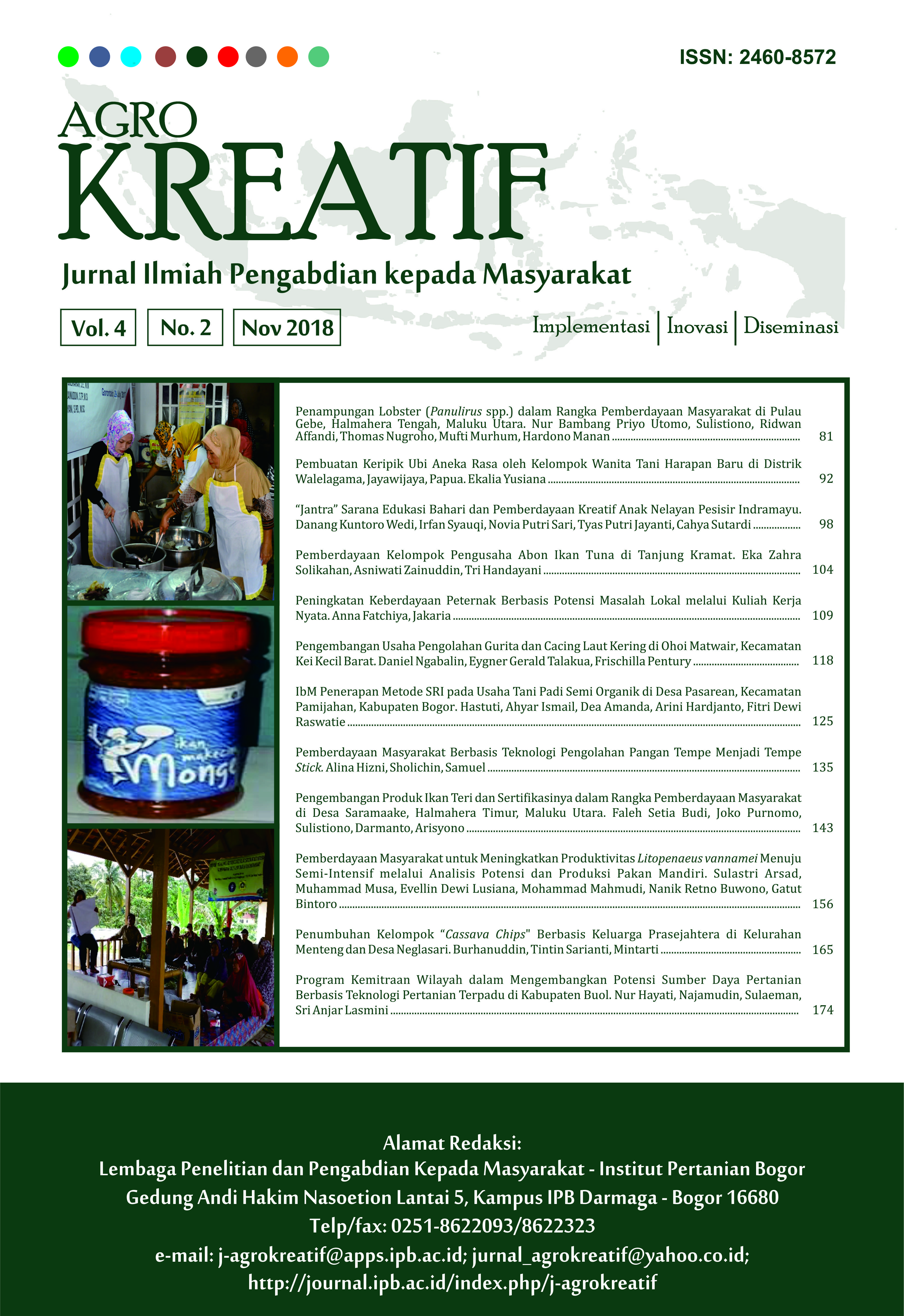Community Empowerment Based on Food Processing Technology Tempe Becomes Tempe Stick
Abstract
Tempe is one of the processed products of soybeans. Tempe can be further processed into tempe stick by the community through science and technology based entrepreneurship. The targets of this activities are community empowerment in product development, entrepreneurship training and earning extra income. The output of this activities is the diversification of food in the form of healthy food products such as tempe stick. The activities consists of 1) preparation stage (Formulation of formula, analysis of nutritional content of best formula, and manufacture of packaging design and product label); 2) Implementation stage (Entrepreneurship Training, Practice of making tempe stick, Mentoring and Production Monitoring); and 3) Evaluation Stage (Evaluation of sales of stick stick). The result of this activities is obtained a best tempe stick formula with the composition of raw material is wheat (45.0), tempe (45.0), margarine (3.6), lime leaves (1.5), baking powder (0.1), salt (0.6), and water (3.0) with nutrient content per 100 gr tempe stick is energy (464 kcal), water (4.96 g), protein (13.03 g), fat (19.47 g), and carbohydrate (59.08 g). Capital per pack business (100 g) of IDR 3.742 with the selling price of IDR 8.000, then the profit of IDR 4.258 per pack (113.8%). Based on the results of these activities it can be concluded that tempe stick is a nutritious snack food that is feasible to be developed as a profitable business branch.Downloads
References
Almatsier S. 2010. Prinsip Dasar Ilmu Gizi. Jakarta (ID): Gramedia Pustaka Utama.
[BPS] Badan Pusat Statistik. 2017. Konsumsi Rata-Rata Tempe per kapita seminggu 2007–2014 [internet]. [diunduh 2017 Feb 8]. Tersedia pada: www.bps.go.id
Budi FS, Herawati D, Purnomo J, Sehabudin U, Sulistiono, Nugroho T. 2017. Peningkatan Kualitas dan Diversifikasi Produk Ikan Teri untuk Pemberdayaan Masyarakat di Desa Saramaake, Halmahera Timur. Agrokreatif Jurnal Ilmiah Pengabdian kepada Masyarakat. 3(2): 89–99. https://doi.org/10.29244/ agrokreatif.3.2.89-99
Hizni A, Sholichin, Hendarman H. 2016. Iptek Bagi Masyarakat (IbM): Pemberdayaan Kader Posyandu Dalam Pemanfaatan Formula Tempe Menjadi Produk Healthy Food (Laporan Kegiatan Pengabdian kepada Masyarakat). Tasikmalaya (ID): Politeknik Kesehatan Kemenkes Tasikmalaya.
Iswarawanti DN. 2010. Kader Posyandu: Peranan Dan Tantangan Pemberdayaannya Dalam Usaha Peningkatan Gizi Anak Di Indonesia. Jurnal Manajemen Pelayanan Kesehatan. 13(4): 169–173.
Muchtadi D. 2012. Pangan Fungsional dan Senyawa Bioaktif. Bandung (ID): Alfabeta.
Muchtadi D. 2010. Teknik Evaluasi Nilai Gizi Protein. Bandung (ID): Alfabeta.
[Persagi] Persatuan Ahli Gizi. 2009. Tabel Komposisi Pangan Indonesia. Jakarta (ID): Persagi.
Satiawan D. 2011. Tempe. Wacana Didaktika Jurnal Pemikiran Penelitian pendidikan dan sains. 1(6): 25–32.
Saugi W, Sumarno. 2015. Pemberdayaan Perempuan Melalui Pelatihan Pengolahan Bahan Pangan Lokal. Jurnal Pendidikan dan Pemberdayaan Masyarakat. 2(2): 226–238. https://doi.org/10.21831/jppm.v2i2.6361
Soim A. 2017. Tempe - Perencanaan Badan Ketahanan Pangan Provinsi Sumatera Selatan. [internet]. [diunduh 2017 Feb 8]. Tersedia pada: bpk.pertanian.go.id.
Subroto MA. 2008. Real Food True Health, Makanan Sehat untuk Hidup Lebih Sehat. Jakarta (ID): Agromedia.
Syafiq A, Setiarini A, Utari DM, Achadi EL, Fatmah, Kusharisupeni, Sartika RAD, Fikawati S,. Pujonarti SA, Sudiarti T, Triyanti, Hartriyanti Y, Indrawani YM. 2010. Gizi dan Kesehatan Masyarakat. Depok (ID): Universitas Indonesia.
This work is licensed under a Creative Commons Attribution-NonCommercial 4.0 International License.



















